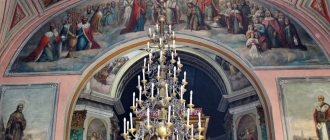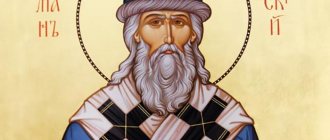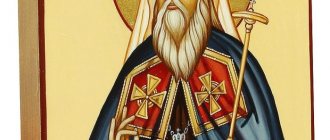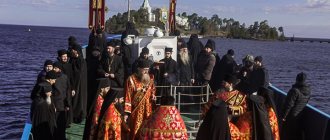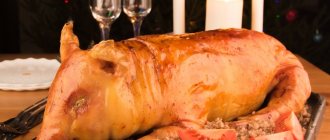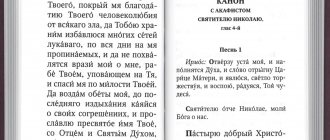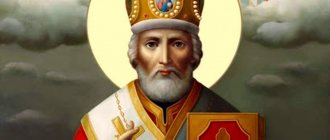| St. Martin, Pope |
Martin I Confessor
(+ 655), Pope, Saint Commemoration April 13 (Greek [1], Italian - “with all the bishops of the West, who suffered for Orthodoxy from the Monothelites” [2]), April 14 [3], September 16 (Antioch. [4], Greek. [5]), September 20 (Greek [6], Italian - “with all the bishops of the West, who suffered for Orthodoxy from the Monothelites” [7])), in the Cathedral of the Crimean Saints
Martin the Confessor was a native of Tudera (now Todi, Umbria, Italy). He received a good education and entered the clergy of the Roman Church. After the death of Pope Theodore I (642-649), Prester Martin was elected to the Roman primate throne.
At that time, the peace of the Church was disturbed by the Monothelite heresy, which became widespread.
Endless disputes between Monothelites and Orthodox Christians occurred in all segments of the population. Emperor Constans (641-668) and Patriarch Paul II of Constantinople (641-654) were also adherents of the Monothelite heresy. Emperor Constance issued a heretical "Model of Faith" (Typos), binding on the entire population. It prohibited any further disputes.
This heretical "Model of Faith" was received in Rome in 649. Saint Pope Martin, a strong champion of Orthodoxy, convened a Local Council in Rome, which condemned the Monothelite heresy.
The angry emperor, trying to prevent the Council, ordered the military commander Olympius to bring Saint Martin to trial. But Olympius, having arrived in Rome, was afraid of the clergy and people who had gathered at the Council, and sent a warrior to secretly kill the pope. When the killer approached Saint Martin, he suddenly became blind. “And so, convinced that the hand of God was protecting Martin, the most holy pope, Exarch Olympius considered it necessary to come into agreement with the pontiff and tell the most holy man everything that he was ordered.” Olympius refused to fulfill the mission entrusted to him and rebelled against the emperor, taking control of the emperor for several years (649-652). Italy. The military expansion of the Arabs and the direct threat to Constantinople for some time did not allow them to suppress this rebellion, as well as take decisive action against the pope, who, from the point of view of the imperial administration, remained only a “former apocrisiary.”
Four years later (653), a year after the death of Olympius, Pope Martin and St. Maximus the Confessor was arrested on charges of treason. Along the way, various accusations were added in words, both religious and political, as if the pope taught unorthodoxly about the Mother of God or that he sent money to the Saracens. By that time, dad had been suffering from gout for several months. The Exarch of Italy Theodore, with a detachment of soldiers, captured Saint Martin at night and sent him to one of the Cyclades islands (Naxos) in the Aegean Sea. For a whole year Saint Martin languished on this almost deserted island, suffering hardships and insults from the guards.
In September 654, the exhausted confessor was brought to Constantinople for trial.
The sick old man was brought in on a stretcher, but the judges rudely ordered him to rise and answer while standing. While the interrogation was going on, the soldiers supported the saint, who was weakened by illness.
“Tell me, unfortunate one, what evil have you intended against the emperor?” - the chairman began the interrogation. Dad was silent. A line of witnesses was put forward. These were Olympius's subordinates and his soldiers. Saving their bellies, they had to earn forgiveness for their participation in the Olympius case by bearing false witness against the pope. And they lied when prompted. The pope, hearing all these abominations, asked the judges not to swear in these witnesses, so as not to aggravate their crimes with perjury.
When they asked Pope Martin what he would say to this, he began his speech: “When the Typos was published and sent to Rome...” At this, Prefect Troilus interrupted him: “You should not talk about faith, but only about rebellion and your participation in him. You knew that Olympius was forging chains on the emperor, and you did not stop him. On the contrary, you were in cahoots with him.”
“Well, and you,” answered dad, “did you prevent George and Valentin from rebelling against the emperor?” (This was an uprising in Constantinople, through which Konsta, now reigning, was installed) “Did you manage to prevent it? So how could I (unarmed), what could I do against a man who had all the land and naval forces of Italy? “To this dad added: “I ask you, for Christ’s sake, quickly do with me what you want. Every death will be a blessing for me."
The Pope was carried out on his stretcher into the atrium, i.e. into the courtyard of the court chamber, where an incited crowd had already gathered; from here he was put on a special platform, specially designed for showing criminals to the crowd. On the contrary, from the balcony of his palace the emperor could see this picture. From him, Prosecutor General Vukoleon returned with a death sentence. Members of the synclite - judges - gathered around the condemned martyr. The official addressed the pope: “You fought with the emperor, what do you hope for now? You have retreated from God, and God has retreated from you.” And he ordered his patriarchal omophorion (ψαχνιον) and his black and white boots, the signs of his rank, to be torn off from the pope. Handing them over to the mayor (prefect), he said: “Take them and cut them into pieces.” Then they tore off the pope’s outer priestly robe, and tore his lower tunic in many places, thus half-exposing the pope’s body. The official invited the crowd to anathematize the criminal. Only a few responded. The people were dejected and sighed with sympathy for the sufferer. Only the rabble reviled the “criminal.” With a chain around his neck and the presentation of a sword, the pope was taken through the city to the guardhouse (praetorium) and thrown into a cell with criminals. An hour later they took him to a cold solitary confinement cell (in Diomede prison) with such cruelty that they wounded his legs and covered the prison stairs with blood. Martin was half dead. One cleric of the pope, however, was allowed to remain with him for services, but under the supervision of a special guard appointed to guard those on death row. The prison guards, mother and daughter, when the authorities left, were able to slip a blanket through the sufferer so that he would not freeze. Late in the evening, a messenger from the mayor Gregory appeared with food - to express the hope that “God willing, dad will not die like this,” and ordered the shackles to be removed from his neck. Dad didn't say anything, just took a deep breath. He sincerely wanted nothing more than the martyrdom of his ordeal.
Meanwhile, the emperor came to the dying Patriarch Paul of Constantinople and told him about the trial of Saint Martin. He turned away from the emperor and said: “Woe is me! Another new act to my condemnation,” and asked to stop the torment of Saint Martin. The emperor again sent a notary and other persons to the saint in prison for additional interrogation. The saint answered them: “Even if they fragment me, I will not be in communion with the Church of Constantinople while it remains in evil faith.” The torturers were amazed by the courage of the confessor and replaced the death penalty with exile to the remote Tauride Chersonese.
After three months in prison, in March 655, the saint was secretly loaded onto a ship and taken into exile in the Crimean Chersonese.
From here he wrote several letters reflecting his suffering in this “bearish” corner of the Byzantine state, among the barbarian population and in deprivation, without the necessary food. Here, at the crossroads of the grain road from Scythia to Greece, the pope was not given bread. He complained in a letter: “Bread is known here only by name... I was and am surprised at the indifference of my friends and relatives.
They forgot about my misfortune. It seems they don’t even want to know whether I still exist in the world or not. Although the Roman Church does not have money, it is rich, by the grace of God, in bread, wine and everything necessary for life. Obviously, fear has fallen on people, so that they shun even the fulfillment of God’s commandments, fear where there should be no fear.” Dad was really sad that the outburst of love for him, which he witnessed during his first arrest, completely disappeared. St. Martin was also upset that the Roman clergy betrayed him in principle and canonically. When he was still on the island of Naxos, they had already appointed a new pope, Eugenius, on August 10, 654, and elected him even earlier, taking into account that this date was already the date of imperial approval. At the time of Eugene's election, Pope Martin had not yet been formally tried and convicted. The clergy fainted in the face of police pressure.
St. Martin died on September 16, 655, exhausted by illness, poverty, hunger and deprivation. He was buried outside the city in the Blachernae Church in the name of the Most Holy Theotokos.
The heresy of the Monothelites was condemned at the VI Ecumenical Council in 680. The relics of the holy confessor Pope Martin were transferred to Constantinople, and then to Rome.
early years
The boy was born in the city of Tubertuma. This place is located in Italy in the Tuscan region. Martin received a good education for that time, which allowed him to enter the clergy of the Roman Church.
Beginning of ministry
Pope Theodore I died in 649. Martin was immediately installed on the holy throne. The times of his reign coincided with the widespread spread of heresies. In addition, even then the Roman and Constantinople churches were not united. Stratifications and divergences manifested themselves in all segments of the population.
Saint Martin the Confessor
The Emperor of Byzantium and even the Patriarch considered themselves to be part of the Monothelite heresy. They produced the “infidel” Pattern of Faith. This creation was a must read.
The book soon reached Rome. Being an ardent Orthodox Christian, Pope Martin immediately convened a Local Council in Rome. At this meeting, the Monothelite heresy was condemned and recognized as an incorrect teaching. A request for a return to the correct faith was received by both the Emperor of Byzantium and its Patriarch.
The ruler was so furious that he ordered his close associate Olympius to kill the holy Pope. The military leader hired an assassin and sent him to the Pope. It was then that the first miracle associated with Martin the Confessor happened. As soon as the killer approached the Pope, he suddenly became blind. Olympius himself soon fell in a terrible battle.
A fall
The Emperor of Byzantium realized that Martin's faith was too strong. Moreover, the common people were on his side. Then the ruler took a different path. In 654, another Byzantine subject, Theodore, came to Rome. He charged Pope Martin with secret communication with enemies of the empire and faith, as well as defamation of the Blessed Virgin Mary and illegal acquisition of the papal throne.
Despite Martin's innocence, at night Theodore with a detachment of armed soldiers burst into the Pope's room and arrested him. Martin was thrown into prison on one of the Aegean islands. Only a year later, Martin was taken to Constantinople for trial.
The confessor was so exhausted by imprisonment that he did not even have the strength to stand on his feet. Despite this, the judge ordered the old man to answer while standing. The guards held him like that, causing even more pain to the patient.
Icon of Saint Martin, Pope
No one was going to listen to the sick old man's excuses. The verdict was known in advance. Martin was chained in the square. People were encouraged to shout: “Anathema to Pope Martin!” Those who believed in Martin's innocence could only leave the square with tears in their eyes.
This is interesting! Anathema - renunciation from the church. The most famous anathemas were assigned to the Pope and the Orthodox Patriarch during the schism of Christianity in 1054. The renunciation of the church was mutual.
Pope Martin was sentenced to defrocking and death. At the behest of the emperor, who was condemned by the Patriarch, people were sent to the Confessor to conduct a new interrogation. However, Martin said: “Even if they crush me, I will not be in communion with the Church of Constantinople while it remains in evil faith.”
Death
The Emperor of Byzantium was amazed by the courage of the Pope and replaced the death penalty with lifelong imprisonment in Tauride Chersonese. There he died on September 16, 655, exhausted by poverty and hunger. Martin's body was buried outside the city walls. However, after the condemnation of heresy in 680, the remains of the Holy Pope were transferred to Constantinople and then to Rome.
About the relics of the revered martyrs:
- Relics of the Holy Princess Elizabeth Feodorovna
- Relics of St. Tikhon of Zadonsk
- Relics of Saint Prince Alexander Nevsky
Saint Martin of Tours, bishop
Gracious or Martin of Tours is the Bishop of Tours. He became one of the most revered French saints. Martin lived during the existence of Candia or Lugdunian Gaul, which was part of the Western Roman Empire.
Martin became the patron of Christianity for the inhabitants of Europe. During his life, he actively propagated traditions for monasticism, but at the same time he himself was a good example.
The Bishop of Tours always dreamed of becoming a monk, but he did not fully succeed. The holy bishop was called to serve in the rank, since the inhabitants wanted to see only his person as the head of the church. The saint realized his dreams of a monastic life when arranging the monastery, which was built next to the places of solitude of the former officer Martin.
Life story
Martin was born in what is today Hungary. It was a place called Pannoni, where the deeds of St. Anthony the Great were well known. Since childhood, the boy dreamed of a monastic life. The boy's family was non-Christian; his father forced him to choose a military career. Therefore, the future saint ended up in the territory of Gaul, where he was forced to serve as an officer.
The military is accustomed to toughness, especially when it comes to commanding officers. But this statement did not apply to Martin. He treated every soldier with understanding. One day he tore his military commander’s cloak and gave it to a naked civilian whom the army met on the street. This act led to the fact that Martin the saint began to be compared with Christ.
Then the future saint refused to fulfill his military duties. Martin claimed that he could only fight an enemy with the help of a cross, and that he only took a sword for a criminal. As soon as the opportunity to leave the army arose, Martin did so. He hastily relieved himself of all duties in order to retire to where there was desert. This place near Poitiers was secluded, but soon a small monastery grew there. According to the author of the saint's life, this monastery became a real center of monastic life. The saint actively spread the traditions of Eastern monasticism.
Martin wanted simple solitude, but the Lord decreed otherwise. The future saint was called to Tours to heal the sick woman. But it was a trick. There Martin was proclaimed bishop. Although before this he had avoided even being appointed to the position of a simple deacon. But the merciful one never gave up his dream of monasticism, although he realized that his calling was to help people and guide them on the true path.
The first thing the saint did was to establish a monastery on the territory of Marmoutier.
Special rules for monks were also established there:
- desire for humility;
- patience;
- common property for everyone;
- obedience to mentors.
The mentor himself set an example. He prayed a lot, ate little, and wore rough, simple clothes.
Martin's death is dated to the 5th century. There he died while praying. There, in the temple at the intersection of the Vienne and Loire rivers, residents wanted to bury him. But the inhabitants of Tours stole the relics and sailed upstream in boats. There, the local population retained legends that said that flowers bloomed along the route and birds sang. Today the relics remain on the grounds of the Basilica of Tours, named after Martin.
Day of Remembrance
The dates of veneration differ for different movements. On November 11, Saint Martin is traditionally remembered by Catholics and Lutherans. Orthodox Christians celebrate this day on October 12th.
November marks the end of the harvest season for most European countries. In the veneration of Martin, the traditions of pagans and Catholics came together. These days of honor are especially loved by children, as they participate in a real celebration and traditionally receive gifts.
Churches
An interesting fact is that even churches are dedicated to Martin the Confessor. This phenomenon exists in both the Catholic and Orthodox churches.
Church of St. Martin the Confessor on Taganka, Moscow
So worth mentioning:
- Church of St. Martin I in Evpatoria (Roman Catholic Church).
- Church of St. Martin the Confessor in Moscow.
- Church of St. Martin the Confessor in the St. Clement Inkerman Monastery.
- Church of St. Martin the Confessor in Arkhangelsk.
Holiday traditions and customs
One of the holiday customs is to serve baked goose. According to legend, one day during a service, geese began to scream and rage near the church. The bishop interrupted the service and ordered the geese to be roasted. Since then, geese began to be served at the table in all houses of the tour on November 11th.
The second custom is to serve cookies from butter dough, which were baked in the shape of a horseshoe. The cookies were called "Martin's cones." For the horns, a special dough was mixed, which had to stand for several days. Housewives prepared for this celebration in advance: they bought food, marinated the goose, and kneaded the dough.
Another tradition related to the way the harvest was celebrated. Nuts, apple pieces, grains, and crackers were collected in paper bags, hung from the ceiling and paper ribbons were attached to them. After the annual address of the ruler of Tura, paper ribbons were set on fire, and food was poured onto the heads of those celebrating. This action symbolized the harvest and abundance.
Times of ruin
Until 1917, schools and almshouses were opened at the church, and patronage services were provided for the poor. However, after the revolution, the complex repeated the fate of many shrines. It was plundered and closed in 1931. The church premises were given to the Vostokkino film workshop. At this time, the iconostasis was destroyed, and the interior of the temple was completely plundered. Later, the All-Union Book Chamber occupied the premises, placing a literary fund in the temple.
Where are the relics of the saint?
One day, when Bishop Martin went to another city to reconcile clergy who were in a quarrel, he became seriously ill. After some time, during prayer, the Monk Martin departed to the Lord. This happened in 397. In the monastery founded by Martin the Merciful, no more than 80 people carried out their obedience. But his fame was so great that about 2,000 monks came to say goodbye to him.
Some time after the death of the saint, a basilica was erected over his tomb. In 1562 it was destroyed by Protestants who violated the relics of the saint. Soon pieces of the relics were spread throughout the country. Part of the relics of Saint Martin is kept in Tours in the reliquary of the main altar of the Basilica of Saint-Martin.
It is known that the relics of the saint brought many miracles. Many of them were described by Bishop Gregory of Tours in his writings.
Sunday School
Today there is a Sunday school at the church. Its goal is the Orthodox upbringing and education of children in the spirit of Christian values. Children learn to participate in Confession and Communion, study the Law of God, church history, and the course of Orthodox worship. School education is free. Pupils are required to have a neat, modest appearance, reverent attitude towards church utensils, and regular participation in worship.
What do they pray to Martin the Merciful for?
The saint is considered the patron saint of the poor, warriors and people who engage in agriculture. In prayers, people ask to be delivered from poverty and ask for prosperity and good luck in their work.
Prayer to Martin the Merciful for poverty
O most pure and merciful Saint Martin, Bishop of Tours, trustee and protector of the poor, called the Merciful. Pray for our salvation from troubles and sorrows, from plague and empty money, protect us from hunger and cold, from physical and mental illnesses. Help, Saint Martin the Merciful, to bear all the hardships of life and not to lose the holy faith. Pray for us to our All-Bountiful and Most Merciful Lord, the Glorified Heavenly Father in the Trinity. You are our hope and hope, we send thanks to you and with you we glorify the One Trihypostatic God, Father, Son and Holy Spirit, now and ever and unto ages of ages. Amen."
Complex in the 19th century
At the beginning of the 19th century, the Italian painter Antonio Claudo painted the temple; his works have been preserved on the walls of the complex to this day. The same master made the icons for the main iconostasis. The Italian style of painting was uncharacteristic for temples of that time. Thus, subjects that are not typical of Orthodox churches appeared in the church: the image of Moses and the Apostle Peter.
In 1806, the temple was consecrated by Moscow Metropolitan Platon.
The year 1812 brought misfortune; the temple was badly damaged by fire. Therefore, from 1813 to 1821 it was restored, restoring the floors and cladding. In the 19th century, the main temple functioned without heating. Only at the beginning of the 20th century, the merchant Sergei Alexandrov contributed to the organization of calorific heating. In addition, the picturesque interior design has been updated.
